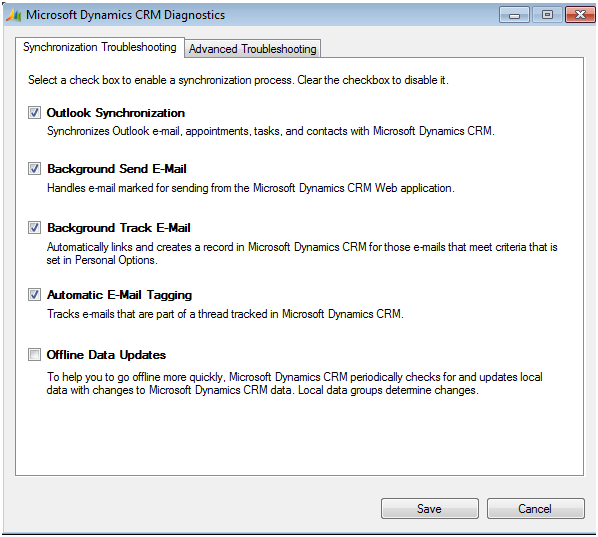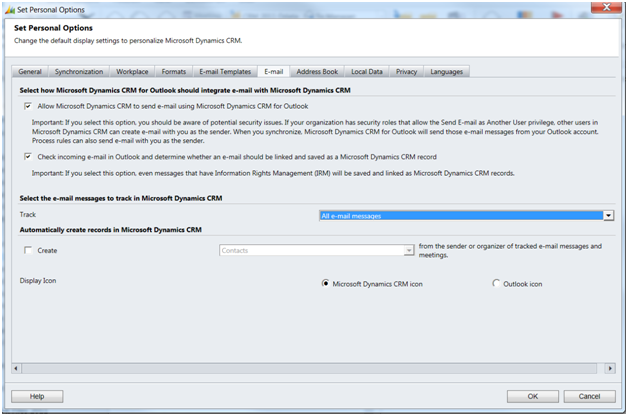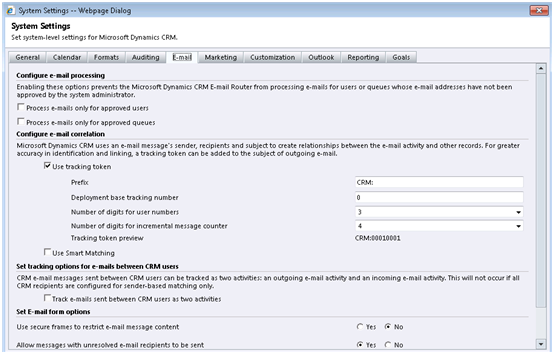The power of Microsoft Dynamics CRM as far as tracking emails is great. It is also a little overwhelming. I have written this Blog to try to describe the different options available to the end user and organization. I will also indentify where to go to modify the required settings.
Having the ability to automatically track and promote emails within Dynamics CRM and correlate email activities to the appropriate Dynamics CRM record can be a daily activity for many Dynamics CRM users. What’s more, many users want the ability to automatically track the entire thread of an email in Outlook back to a record in Dynamics CRM.
The following are different settings that need to be considered when configuring e-mail tracking in CRM:
Step 1: Microsoft Dynamics CRM Diagnostics
The first location we will be looking at is the Diagnostics tool that is installed with the Dynamics CRM for Outlook client. To find this, navigate to Start | All Programs | Microsoft Dynamics CRM 2011 | Diagnostics on a client workstation that has the Dynamics CRM for Outlook client installed. Check the following:

The following summarizes the functions of the various settings in Microsoft Dynamics CRM Diagnostics:
- Outlook Synchronization – This controls synchronization between Outlook e-mails, appointment, tasks and Contacts. Leave this checked if you want to enable tracking.
- Background Send E-mail – This controls sending e-mails from Dynamics CRM. Leave this checked if you want to send e-mails directly from Dynamics CRM.
- Background Track E-mail – This controls the automatic tracking in Dynamics CRM during the synchronization process. Leave this checked for automatic tracking purposes.
- Automatic E-mail Tagging – This controls the process for polling the Dynamics CRM server for messages that are currently tracked in Outlook. In other words, it will retrieve any changes from the Dynamics CRM server to Outlook for modified e-mails only, thus automatically capturing the email string that was originally tracked in Dynamics CRM.
Step 2: Personal Options
If an organization or users are going to use the Outlook client to automatically track and promote e-mails within Dynamics CRM, personal options must be configured to allow the Dynamics CRM for Outlook client to handle e-mails on their behalf. To access the user’s Personal Options they will need to open Outlook and navigate to File | CRM | Options for Office 2010 and CRM | Options for Office 2007 and check the following:

The following summarizes the functions of the various settings in Personal Options:
1. Allow Microsoft Dynamics CRM to send email using Microsoft Dynamics CRM for Outlook – This checkbox allows e-mails created and sent from the Dynamics CRM web client to be sent using the Dynamics CRM for Outlook addin through Office Outlook. You will notice these e-mails appearing in the Sent Items folder of the Mailbox.
2. Check Incoming e-mail in Outlook and determine whether an e-mail should be linked and saved as a Microsoft CRM record – This option is only enabled if the Background Track e-mail checkbox is marked in Diagnostics. This setting will check incoming e-mails based on the System Settings configured to see if a record should be linked and saved in Dynamics CRM as a record
3. Select the e-mail messages to track in Microsoft Dynamics CRM – the following summarizes the various options:
- All e-mail messages – This will track all e-mail messages regardless no matter if it is a Dynamics CRM record or not
- E-mail messages in response to CRM e-mail – This will track e-mails in response to current e-mails based on either the Tracking Token or Smart Matching configuration in System Settings. It looks to see if this e-mail has already been tracked in Dynamics CRM as well as the tracking token if one is being used.
- E-mail messages from CRM Leads, Contacts and Accounts – This will only track e-mails only if the sender is a lead, contact, or account.
- E-mail messages from CRM records that are e-mail enabled – This will track e-mails from all record types (all entities), including custom record types (custom entities) that contain an e-mail address field.
4. Automatically create records in Microsoft Dynamics CRM – This will automatically create a Contact or Lead in Dynamics CRM using the sender or organizer e-mail address if the Contact or Lead does not already exist.
5. Display Icon – This is checked by default and will display in Outlook if an item is being tracked.
Step 3: System Settings
System setting within Dynamics CRM determine what options are available for configuration. To access the System Settings navigate to Settings | Administration | System Settings | E-mail tab.

The following summarizes the functions of the various settings in Dynamics CRM System Options:
1. Configure e-mail processing – By default, after a user is added or a user’s e-mail address is changed, that e-mail address must be approved by a system administrator. However, you can change the requirement that e-mail addresses must be approved by selecting
- Process e-mails only for approved users
- Process e-mails only for approved queues
2. Configure e-mail correlation (Tracking Token and Smart Matching)
- Use Tracking Token. This creates a tracking token in the Subject line of an e-mail to help Dynamics CRM determine if the e-mail should be tracked.
- Smart Matching – Smart matching relies completely on the existence of similarity between emails. The subject and recipients (from, to, cc and bcc) list are the two important components that are considered with checking for similarity. To find the correlation between the incoming email and the outgoing email the stored subject and recipient hashes are searched for matching values. Two emails are correlated if they have the same count of subject hashes and at least two matching recipient hashes.
3. Set tracking options for e-mails between CRM users – Having this checked will create two separate e-mail activities. One owned by the sender for the sent e-mail and another for the received e-mail that is owned by the recipient.
4. Set e-mail form options
- Allow messages with unresolved e-mail recipients to be sent – This will allow you to send e-mails to unresolved recipient.
Understanding the different options and how emails are tracked in Dynamics CRM will help with Outlook integration and tracking automation. If you other questions about the Outlook client or need support for Dynamics CRM, please contact our professionals at crm@mcgladrey.com or by phone at 855.437.7202.
By: Pamela Finnerty – Microsoft Dynamics CRM partner in New Jersey

 RSMUS.com
RSMUS.com